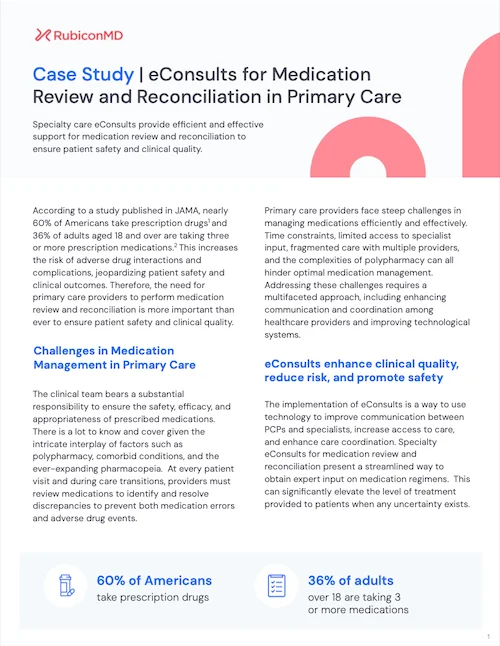eConsults Reduce Specialty Care Fragmentation for Medicare and Medicaid Patients
Primary care providers managing Medicare and Medicaid populations routinely care for patients with multiple chronic conditions, limited access to specialists,…
On Friday, May 1st our Chief of Operations Sarah Alexander hosted a roundtable discussion with a group of CMOs and Executives from leading correctional facilities around the country on how they’re problem-solving in real-time to control the spread and shield inmates from COVID-19.
Overall, leaders were extremely prepared for the pandemic and commended the CDC for putting out correctional guidelines early on to help enforce regulation and minimize spread. They mentioned best practices such as hygiene education, inmate town halls, creating high risk patient cohorts, collaborative staffing policies, and a five level program to triage and manage population within facilities.
In terms of guidelines, Chief of Clinical Operations at Centurion, LLC, Dr. Johnny Wu, who is of Taiwanese descent, was personally tracking cases related to the “Wuhan virus” back in November. In January, Dr. Wu worked with his Corporate Prevention Control team and physician groups to develop Centurion-specific guidelines prior to the CDC. Dr. Wu says that “PPE wasn’t an issue because of our extensive supply chain [as a subsidiary of Centene]. We’ve done mass testing for 350,000 inmates across the organization and have had extremely low mortality rates because we were so well prepared.” Centurion also pushed to advance telehealth capabilities to get ahead of rising healthcare concerns by updating their IT networks and data infrastructure across facilities.
Similarly, Chief Medical Officer at CoreCivic, Dr. Keith Ivens and Deputy Chief Medical Officer Yvonne Neau say they had “forward thinking executives who started committee planning early on based on CDC recommendations…purchasers scoured the globe trying to find masks, gowns, boots and goggles and wardens conducted town halls on hygiene education, trying to keep inmates as calm as possible to help limit potential uprising.”
Dr. Travis Schamber, Corporate Medical Director at Advanced Correctional Healthcare, Inc. was also leveraging the CDC to prepare his facility ahead of time. “We were screening people early on back in January when it was a level 2 threat. The biggest thing to do is identify and screen. We have the resources but we aren’t going to dictate something that the CDC isn’t telling us at this point unless our frontline staff report a unique situation.”
Although the CDC’s correctional guidelines have been tremendously useful, there was a general consensus that the growing divide between local health department recommendations and CDC guidelines is challenging as each state and county is at a different point along the COVID-19 maturity curve.
Another critical factor for preventing transmission has been triaging high risk inmates and separating or reducing populations when feasible. Dr. Ivens said that the negative publicity that cruise ships received for not separating their populations prompted him and Dr. Neau to develop a program as soon as possible. They divided their population into five cohorts with the same officers working in designated cohorts. Population 1 consisted of new inmates that are quarantined as soon as they get bused in. Population 2 is composed of high risk inmates that are geriatric and/or have comorbidities. Although Dr. Neau claims “labelling people is not normally viewed well in correctional settings, we had to focus on protecting our most vulnerable inmates. Today, our mortality rate is nearly 0% and hospitalizations are very low.” Population 3 is COVID-19 positive inmates who are sent to negative pressure rooms and Population 4 is inmates who have been exposed to positive COVID-19 inmates and are now in quarantine. Population 5 is the general inmate population. Although this requires facilities to be large enough to house five distinct populations, including negative pressure rooms, it has proved highly effective for the CoreCivic team.
Medical Director at Wisconsin Department of Corrections, Dr. Paul Bekx says that another way to reduce the number of COVID-19 cases is by reducing the inmate population. “We go through a series of very collaborative processes in which inmates who may be eligible for parole or meet certain geriatric parameters or have extraordinary health conditions are each assessed individually.”
Lastly, all leaders agree that a crucial element for staying ahead of the curve in corrections is having the flexibility to change course and the humility to let go of prior decisions made. Dr. Ivens said “we need to be humble enough to say that was good for March, but now it’s April and we may need to pivot as new information comes in, even if that means re-doing all of our questionnaire forms for up-front screening at the door.”
It was deeply humbling to speak with correctional leaders across the country who are tirelessly committed to fighting the pandemic within their facilities and guiding their organizations through great leadership.
Primary care providers managing Medicare and Medicaid populations routinely care for patients with multiple chronic conditions, limited access to specialists,…
In a recent RubiconMD CME webinar, “Trauma-Informed Primary Care: ACEs, PTSD, and Chronic Stress,” Ludwing Salamanca, MD, PhD of Columbia…
As primary care providers and health systems transition from traditional fee-for-service models to value-based care (VBC), eConsults are a scalable,…

Explore real examples of specialty care eConsults providing efficient and effective support for medication review and reconciliation.